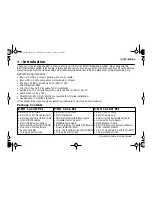
frequency response will be directly related to the sample rate of the
S/PDIF input data.
MULTITRACK DRIVER DEVICES: The Delta TDIF drivers intelligently
synchronize the beginning of recording and playback across all audio
devices on the board. When using application software that is capable of
using multiple channels simultaneously, select "Single and In-Sync" to
ensure that all audio channels will begin playback and/or recording at
the same time. Otherwise select "Independent" to allow the audio
channels to play independently – this setting may be desirable if more
than one application needs to access the Delta TDIF simultaneously.
The selection “Multi-card Sync” will remain grayed out until a second
Delta PCI card (of which there are a variety) is installed in the system.
When you wish to synchronize two (or more, up to four) Delta cards,
select Multi-card Sync on the second and successive cards. This ensures
that when the application goes into record or playback, it waits until all
audio ports are open before it commences with recording or playback of
audio. Then, select S/PDIF as your master clock, and connect the S/PDIF
output of the first card to the S/PDIF input of the second card, etc.
DMA BUFFER SIZES: This section specifies the amount of system
memory dedicated to digital audio buffering. Setting a buffer size that is
too small may result in clicks or pops in the audio stream as some data
may be lost. Larger buffers cause slightly more latency but prevent the
pops and clicks that might occur with smaller buffer sizes – the default
settings are recommended but you may desire to tweak these default
settings to suit your tastes. This buffer size must be set in the Delta
Control Panel before you launch your music software. When using ASIO
with the Delta TDIF, set the buffer size in the control panel, then exit the
control panel. After doing so, launch your music software.
VARIABLE OUTPUT LEVELS: The software switches in this section
allow the user to match analog output levels to the operating signal levels
of the external audio equipment. Two level selections are available:
‘Consumer,’ and –10dBV. The ‘Consumer’ setting is the least ‘sensitive’
of the two settings, and ‘–10dBV’ the most sensitive. Therefore, the
‘Consumer’ setting has more headroom and can accept the hotter signals
of the two settings. Consult the user guide of your external audio
equipment regarding your equipment’s input line level.
INPUT AUDIO SOURCE: The Delta TDIF breakout cable includes inputs
for both analog and S/PDIF connections. However, only one of these
inputs, either Analog or S/PDIF, may be selected and used at one time.
This section provides a software switch that allows you to select between
26
















































